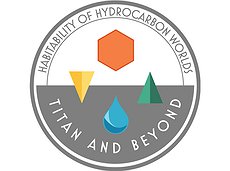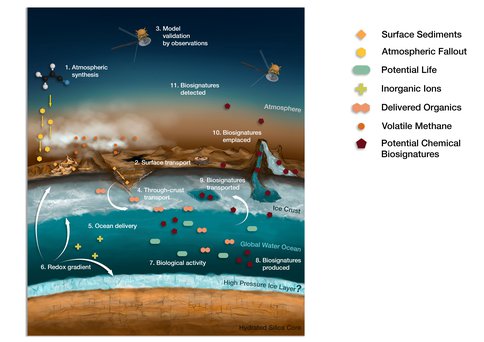NASA Jet Propulsion Laboratory - Titan
05/2018 -
04/2023
(CAN 8)
Habitability of Hydrocarbon Worlds: Titan and Beyond
The single compelling question for this research is: What habitable environments exist on Titan and what resulting potential biosignatures should we look for? The specific objectives to be addressed by this NAI team are:
- Determine the pathways for organic materials to be transported (and modified) from the atmosphere to surface and eventually to the subsurface ocean (the most likely habitable environment),
- Determine whether the physical and chemical processes in the ocean create stable habitable environments,
- Determine what biosignatures may be produced if the ocean is inhabited, and
- Determine how biosignatures can be transported from the ocean to the surface and atmosphere and be recognized at the surface and in the atmosphere.
OBJECTIVE 1: Determine the pathways for organic materials to be transported (and modified) from the atmosphere to surface and eventually to the subsurface ocean (the most likely habitable environment).
Investigation 1.1: What is the chemical content of the atmosphere and its contribution to the surface inventory? The JPL-Titan team will use both modeling and observations. The observations will focus on assaying Titan’s molecular inventory through fitting of data from multiple sources: Cassini CIRS infrared spectra; sub-millimeter spectra from the ALMA observatory; SOFIA/EXES and IRTF/TEXES. The retrieved molecular abundances as a function of latitude and altitude will be used to constrain a state-of-the-art photochemical model. The modeling will be focused on developing a 2-D model of the Titan atmosphere, from the surface of Titan to its top. The team will use the JPL/Caltech KINETICS code which already has 2-D capabilities (altitude and latitude). The required dynamical parameters will be provided by global circulation models (GCMs). Model results will be iteratively compared to observational results as available, and used to improve and refine the model through updated reaction pathways, rates and branching ratios. In addition to predictions of the atmospheric composition, the output of the model will include the fluxes of organics onto the surface of Titan as a function of location and season to be used by Inv. 1.2.
Investigation 1.2: How are molecules transported across the surface and deposited/modified? The JPL-Titan team will approach this question from three directions: laboratory experiments, observations, and modeling. Cassini observations have demonstrated that Titan’s surface is subject to a variety of surface processes. However, there are competing hypotheses to explain how material is transported. This team will evaluate differing scenarios for climate and surface evolution on Titan by coupling morphometric data analysis with hypothesis-driven landscape evolution models that can simulate geomorphic processes including fluvial erosion, deposition, dissolution and re-precipitation in transporting both organic and inorganic material. They will also perform laboratory experiments to determine what reactions organic molecules can undergo under Titan surface conditions, and will examine the interactions between the lower atmosphere and the surface and provide compositional constraints on the surface units using Cassini-Huygens data mainly from RADAR and VIMS (Visual and Infrared Mapping Spectrometer). This will include extracting haze properties, searching for temporal variability that indicates atmospheric or geologic activity, constraining surface properties, investigating aeolian and fluvial/pluvial transport on the surface.
Investigation 1.3: What are the pathways for molecules to be transported from the surface to the ocean? The astrobiological implications of Titan’s surface (younger than 500 Myr) will be investigated using modeling and laboratory experiments, bringing together experts in physical and organic chemistry, geodynamics, and glaciology. The JPL-Titan team will model possible modes for tectonic overturn in Titan’s ~50-80 km thick icy lithosphere to evaluate how materials from the surface can reach the interior. At the near-surface they will evaluate fracturing and permeability informed by observed geology (Inv. 1.2). In the deeper part of icy lithosphere, they will consider the role of clathrates and fluids in two-phase convection. A key part of this work is the transformation of materials between the solid, liquid and gas phases, hence this team will also perform laboratory experiments to examine the chemistry that occurs in water ice/organic mixtures as they are subjected to the temperature/pressure condition in the subsurface during transport. These experiments are needed for Objective 2, as they provide detailed information on the types of molecules that reach the ocean.
Investigation 1.4: Does organic transport to the subsurface ocean result in habitable environments along the pathway? This investigation will use the results of Invs. 1.2 and 1.3 to assess whether there are signatures of these environments on the surface or in the atmosphere. Inv. 1.3 will provide information on the timescale of transport, temperature, and pressure experienced by surface material as they are transported to the ocean, as well as the chemical composition of the material. Temperature and pressure conditions will be evaluated and compared to known low temperature habitable environments. Chemical conditions will be evaluated for sources of energy (redox gradients). Indications of these habitable environments may include surface geological features or atmospheric chemical or isotopic signatures.
OBJECTIVE 2: Determine whether the physical and chemical processes in the ocean create stable, habitable environments.
Investigation 2.1: What are the possible habitable environments in the subsurface ocean, and what are the conditions in these environments? The JPL-Titan team will use modeling and laboratory experiments to consider whether the likely fluxes of reductants and oxidants materials at different interfaces in the interior could support Earth-like life. At the H2O-rock interface they will use thermochemical models to evaluate how the range of possible rock compositions influences hydrothermal geochemistry, particularly H2 production as a fuel for life. They will use these results in conjunction with newly available high-pressure aqueous chemistry to constrain ocean composition, including the availability and forms of the bioessential CHONPS elements. Detailed geochemical models of Titan’s interior have yet to be made – this team will consider 2-phase solid-state convection in high pressure ices as a means for facilitating material transport and establishing chemical gradients. They will also evaluate the implications of Titan’s size and composition minimizing or eliminating the presence of high-pressure ices, as implied by the recent finding that the ocean must be dense and thus salty. Lastly, the team will experimentally evaluate the mechanisms by which materials from the ocean may be trapped in Titan’s ice, and the chemistry at the ice-ocean interface.
Investigation 2.2: How are organic molecules altered in the subsurface ocean? The results of Inv. 1 will provide a suite of organic molecules that can reach the subsurface ocean. The team will evaluate these molecules in terms of their solubility, reactivity with water, and interaction with ice and minerals to determine their fate in the ocean. These properties will be considered as a function of pH, temperature, salinity, derived from Inv. 2.1. Laboratory experiments will supplement literature data where necessary.
OBJECTIVE 3: Determine what biosignatures would be produced if the ocean is inhabited
Investigation 3.1: What kinds of organisms could live in the subsurface ocean? To address this question the JPL-Titan team assumes that potential life on Titan is bounded by the same chemical and physical constraints as life on Earth, and that potential life on Titan is microbial in form. Accordingly they will then construct potential metabolic schemes and calculate potential energy availability for microorganisms in the subsurface ocean. They will use theorized metabolic and environmental components from both previously published work and from data generated in Invs. 2.1 & 2.2, and then incorporate the scenarios of organic material transfer generated by Inv. 1.4 to produce a concept of what the habitable ecosystem of subsurface Titan could look like. This hypothetical ecosystem can then be tested in the laboratory to verify its potential. The team will seed experiments with samples (and thus organisms) from several appropriate Earth analog systems. The enrichment cultures can then be tested with a wide range of Titan boundary conditions, including organic molecules and electron acceptor/donor pairs to ‘ground truth’ the hypotheses generated by Invs. 1& 2.
Investigation 3.2: What biosignatures would be produced? The team will use the experiments conducted in Inv. 3.1 to determine the isotopic and molecular biomarkers that result from the enrichment cultures, and understand the biochemical basis of their production. Because the enrichments will explore a range of boundary conditions, and utilize samples from several Earth analog ecosystems as inocula, they expect a range of chemical and biochemical biomarkers to be produced by organisms in the enrichments. The expected biomarkers to be included in the database would include isotopic markers such as carbon, nitrogen, and oxygen isotopic signatures of fluids, gases, and solids in the enrichments, and lipid biomarkers of cellular membranes that could carry unique signatures due to the unique chemistry of Titan’s oceans and atmosphere (Miller et al. 2015; Trainer et al. 2015). The database will be made publicly available, along with the metadata generated in section 3.1.
OBJECTIVE 4: Determine how biosignatures can be transported from the ocean to the surface and atmosphere and be recognizable at the surface and in the atmosphere.
Investigation 4.1: What are the pathways for transport from ocean to surface and atmosphere? This investigation mirrors modeling performed in Inv. 1.3, but will also examine the upward transport of convecting ice and/or aqueous solutions (±vapor and entrained solids) through the ice crust, focusing on the implications of differing models of interior structure. The team will draw on treatments of cryomagmatism and, solid state convection, and fracture/fault propagation to address the buoyancy of cryovolcanic fluids and the potential formation of shallow melt lenses that could facilitate eruptions to the surface. In addition, they will use constraints on interior heat flow to evaluate how clathrates and hydrocarbon liquids may turn into gases to drive explosive venting.
Investigation 4.2: How are molecules altered on transport from the subsurface ocean to the surface? This investigation mirrors laboratory work performed in Inv. 1.3. The JPL-Titan team will examine the chemistry that occurs as ocean fluids are subjected to the temperature/pressure conditions in the subsurface during transport to the surface. Initial work will focus on the formation of minerals and hydrates from ocean brines, and their interaction with ocean organics. They will also investigate the chemistry that results when ocean fluid contacts surface organics.
Investigation 4.3: Does transport to the surface result in habitable environments along the pathway? Are there signatures of these environments on the surface or in the atmosphere? To understand the global context of Titan’s habitability necessary for interpreting potential biosignatures, the JPL-Titan team will use the tools of Inv. 2.1 to consider the sources and sinks of oxidants specific to hydrocarbon-water chemistry. This development of “Titan system science” mirrors similar efforts to understand the net global effect of exchanges of carbon, nitrogen, and other bioessential materials in their different oxidation states between reservoirs (atmosphere, ocean, seafloor etc) on Earth and elsewhere, drawing from subdisciplines in geology, chemistry, biology, and geophysics.
Investigation 4.4: How would we detect biosignatures that reach the surface and atmosphere? Biosignatures would be emplaced onto the surface as the final step in transport of material from the subsurface ocean. The specific molecules judged to be biosignatures will be provided from Inv. 3. Laboratory near-infrared reflectance spectra of putative ocean fluids will be acquired, both with and without biosignatures, in order to ascertain detectability. The team will also acquire spectra of the chemical signatures resulting from ocean fluid/organic interactions studied in Inv. 4.2. These spectra will provide baseline measurements that may be useful to target selection in future missions. Volatile biosignatures might be found in the atmosphere; in which case the JPL-Titan team will determine the best methods to detect these species, either through remote observations or in situ measurement. They will also explore possible degradation pathways and timescales for these biosignatures.
TEAM LOGO:

-

Rosaly Lopes

-
Active Dates:
05/2018 - 04/2023 -
Team Website:
Coming Soon -
Members:
30 (See All)






